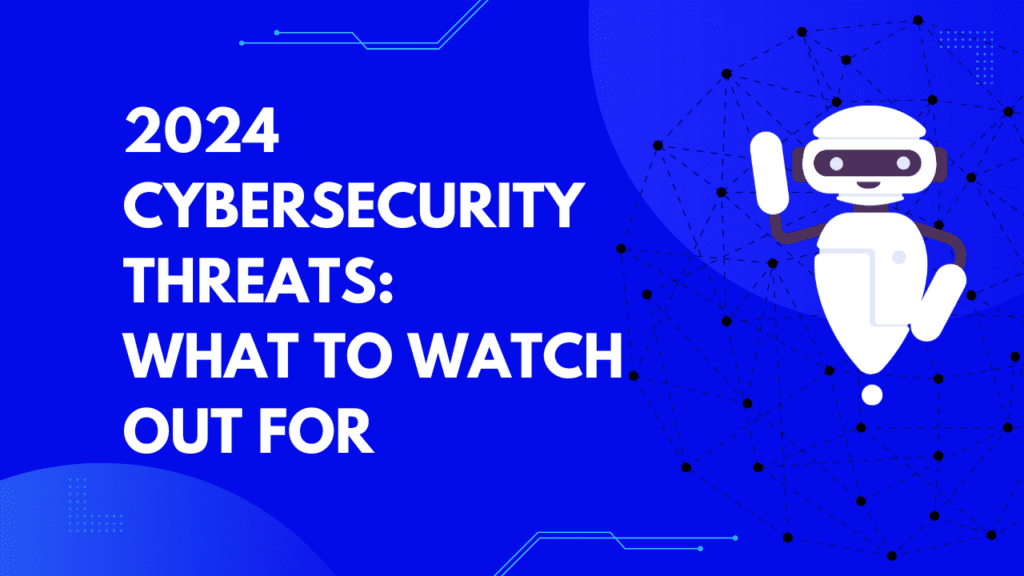2024 Cybersecurity Threats: What to Watch Out For

As technology continues to advance in 2024, so too will the threats facing our data security. Both businesses and individuals would do well to stay informed on emerging cyber risks and prepare defenses against attack vectors aimed at sensitive information theft or destruction.
By learning the latest cybersecurity threats we collectively stand stronger against compromising our digital assets through proactive precautions put in place.
Artificial Intelligence Powers More Sophisticated Attacks
Cybercriminals are already incorporating artificial intelligence (AI) into their attack methods to better identify vulnerable targets, evade security measures, and rapidly spread infections at an unprecedented scale.
As threats powered by machine learning and automation accelerate in 2024, even basic phishing emails will appear strikingly authentic and personally targeted to recipients. AI likewise enables mass data harvesting from breaches to perfect social engineering tactics and launch follow-on ransomware attacks.
On the defensive side, AI and machine learning do provide advanced anomaly detection capabilities to businesses monitoring their networks. However, cybercrime AI development often remains many steps ahead of typical security infrastructure, allowing threats to bypass the safeguards in place.
Supply Chain Vector Targets Software Vulnerabilities
The global software supply chain offers an enticing vector for threat actors to infiltrate networks through vendors downstream rather than trying to breach hardened targets directly.
By implanting malware into popular software updates or legitimate network management tools, cybercriminals can leapfrog security walls and inject their infections deeply into company systems through trusted access mechanisms.
Supply chain attacks will only expand by 2024 as more infrastructure moves to smart devices and remote software. This leaves people caught unknowingly spreading trojans, automated worms, spyware programs, and zero-day exploits simply by following standard IT procedures.
Protecting everything in a hyper-connected world proves impossible, meaning individuals and businesses must grow resilient by isolating critical systems, monitoring carefully for odd network activity, and developing emergency response plans.
Double Extortion Ransomware Crushes Businesses
Unfortunately, 2024 likely bring a swell of ruinous double extortion ransomware attacks targeting key industries like healthcare, finance, and critical infrastructure. These attacks not only lock companies out of their data but also threaten to publish exfiltrated files publicly unless substantial ransom fees meet payment deadlines.
With exponentially more internet-connected systems managing vital societal functions, the scale of disruption cyber extortionists can unleash grows as well between data destruction and theft.
Furthermore, ransomware developers continue to expertly hide within systems for months on end to ensure maximum damage potential and ransom payouts into the hundreds of millions in cryptocurrency once activated.
Proactive efforts like air-gapped backups, widespread staff security training, and incident response drills and planning offer some hope of mitigating fallout when advanced ransomware strikes still inevitably occur.
Deep Fakes and Social Engineering Run Rampant
Cheaper graphics tools and advanced AI are fueling a dangerous rise in manipulated media like deep fake videos exceptionally tough to analyze as fakes even by humans much less security algorithms.
Such synthetic media provides invaluable ammunition to augment social engineering campaigns over channels like email, messaging apps, and social networks.
With surging volumes of data leaks from breaches by 2024 as well, cyber criminals possess abundant personal information to make fraud attempts and scams incredibly convincing.
Phishing threats pose such prolific risks that most enterprises now expect staff to unintentionally click malicious links or attachments eventually regardless of training. Multi-factor authentication and threat intelligence represent crucial layers of protection against the endpoint threats then introduced.
The Threat Horizon Keeps Expanding
In many ways the enterprise cyber risk environment seems bleak entering 2024 as attack capabilities outstrip defense tools trying to prevent breaches across exponentially growing digital footprints. However, all is not lost by expanding security staff knowledge, implementing defense-in-depth technology safeguards, and accepting limitations that incidents likely still occur.
Cyber resilience and response preparations provide perhaps the greatest protective measures organizations can take against adversaries that never stop probing networks for fractional weaknesses to exploit.
By uniting public and private sector knowledge, capabilities, and warnings, collective security improves as well against the ubiquitous data threats facing modern society. Through expanded collaboration, cyber threats become merely manageable risks rather than existential crises for protecting what matters most.
Read More:






